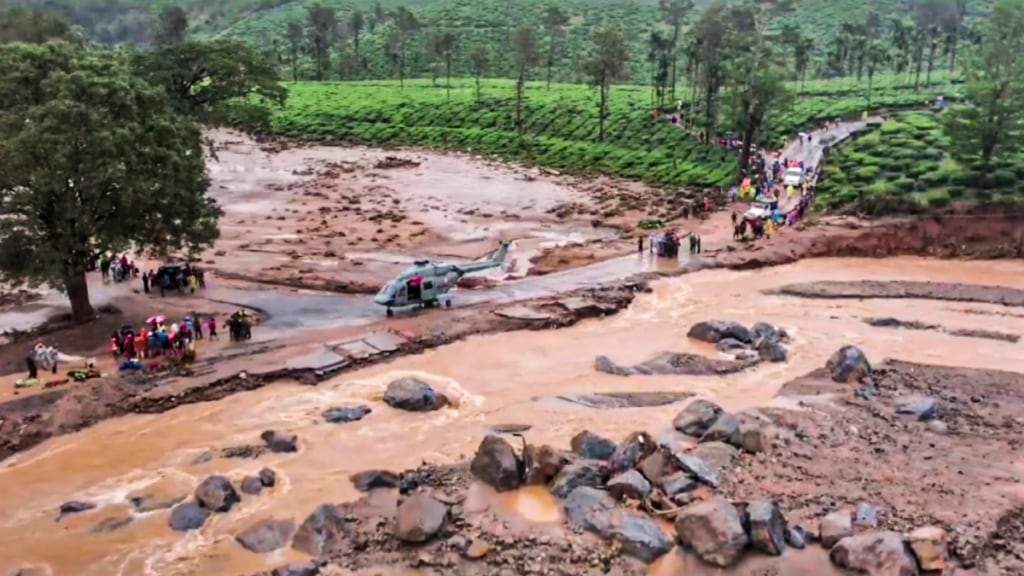Standing in front of his hilltop mud house, Vishnu Ravindran’s face lights up as he reads a new message on his mobile phone. “A family of four is arriving tomorrow,” beams Ravindran, the owner of a homestay in Wayanad, Kerala. “They are the first visitors after the landslide tragedy on July 30,” says Ravindran, the owner of Angels Stay at Thrissilery village in Thirunelli panchayat of Wayanad, summing up the slump in tourist arrivals felt across the vast district. “Only a remote corner of the district was affected by the tragedy, but people linked the landslide with the whole of Wayanad,” laments the young tourism entrepreneur.
In the first fortnight following the landslide, triggered by 590 mm rainfall in 48 hours, Wayanad’s fledgling hospitality industry— from homestays to resorts—suffered losses of Rs 60 crore, says KR Vanjeeswaran, president of Wayanad Tourism Organisation. “The losses from rooms, restaurants and resorts climbed to Rs 120 crore by the end of the month. It was thrice more in sectors like suppliers, transport and retail shops,” says Vanjeeswaran.
The Wayanad Tourism Organisation estimates the total losses for the district hospitality industry at Rs 992.25 crore for the first two months after the disaster. The revenue loss per day was Rs 1.05 crore, while total revenue loss was Rs 220.50 crore. The indirect losses related to the hospitality industry was a whopping Rs 771.75 crore.
The worst-hit in the aftermath of the landslide tragedy were homestays, which account for 1,300 of the district’s 3,000 accommodation units. In a memorandum to the state government, Wayanad Tourism Organisation sought rescheduling of bank loans, waiver of building tax for six months, electricity bills to be deferred for six months and deferred GST payment to help the industry tide over the crisis.
“The tragedy has affected the tourism sector badly and we are trying to make a quick recovery,” says Kerala tourism minister PA Mohammed Riyas, who set up camp in Wayanad soon after the tragedy.
Before the Wayanad disaster, domestic tourist arrivals in the state were at over 15 million in the first six months of this year.
“We brought influencers from across the country to Wayanad and placed advertisements in national and regional newspapers and 15 airports around the country,” says Riyas, who pitched for revival of tourism in Wayanad at the recent Kerala Travel Mart, one of the largest travel trade shows in the country, in Kochi.
As the state beckons a new tourism season, the public and private sectors are working hand in hand to revive the fortunes of Wayanad. After weeks of group cancellations and zero bookings, enquiries and reservations have started to trickle in, offering hope for saving jobs and livelihoods hit hard by the landslide. Wayanad has also received support from high profile visits by Prime Minister Narendra Modi and opposition leader Rahul Gandhi, who won from Wayanad for a second time in the general elections this year before deciding to keep his new Rae Bareli Lok Sabha seat.
Pradeep Murthy, a civil engineer and graduate of the Indian Institute of Management, Bangalore, who owns Muddyboots Vacations, an outdoor travel experience company in the district headquarters town of Kalpetta, says he can already see slow signs of recovery.
“The zip-line is a good indicator of tourist arrivals,” says Murthy, who hosted popular Kannada actor Shweta Prasad this week to boost confidence among potential visitors. “We have started receiving enquiries for bookings. From single digits a month ago, we are now doing double digits and triple digits on our zip-lines at the Banasura Dam and tea plantation in Vythiri,” he adds.
Most of Wayanad’s weekend visitors arrive from the information technology hubs of Bengaluru and Chennai, both lying within driving distance from Wayanad, which borders both Karnataka and Tamil Nadu. “We are doing a lot of promotion for Diwali and Dussehra,” says Shubhangi N, vice-president, sales marketing at GRT Hotels & Resorts. “Come with your pets,” she adds. “Pets stay free of charge.”
According to Taj Wayanad Resort and Spa, one of the few luxury hotels in the district, Wayanad has seen a good recovery “month on month since the landslides”. The hotel chain said its October occupancy levels are on a par with the same time last year. Wayanad Tourism Organisation says the bookings have shown signs of recovery, moving up from zero in the first two months after the landslide to 20% by October-end. The district hospitality industry expects the situation to return to normal by November-end.
But many in the tourism industry like Vinod Ravindra Prasad, president of the Wayanad unit of Kerala Homestay and Travel Society, are uneasy about the long-term impact of the disaster. “After the farmers’ suicides in Wayanad in the past decade-and-half that claimed 100 lives, the district survived the tragedy by integrating homestays with farming,” says Prasad. “If the crisis in the tourism industry is not resolved, we are looking at a situation similar to farmer suicides in Wayanad.”
He laments that there was no financial relief from the government to the tourism industry in Wayanad after the landslide. “It was a positive market before the landslide, but the homestays are seeing weak bookings even during the Dussehra holidays in October, traditionally a strong month for tourism industry in Wayanad,” adds Prasad, owner of Suvistara service villa in Meenangadi.
A quarter of Wayanad’s 800,000 population, many from the tribal communities, is dependent on the tourism sector. The District Tourism Promotion Council figures say Wayanad received 2.3 million visitors last year, placing the district fifth on the list of domestic tourist arrivals in Kerala. The district is classified as highly vulnerable to natural calamities under the Kerala State Action Plan on Climate Change 2023-2030.

